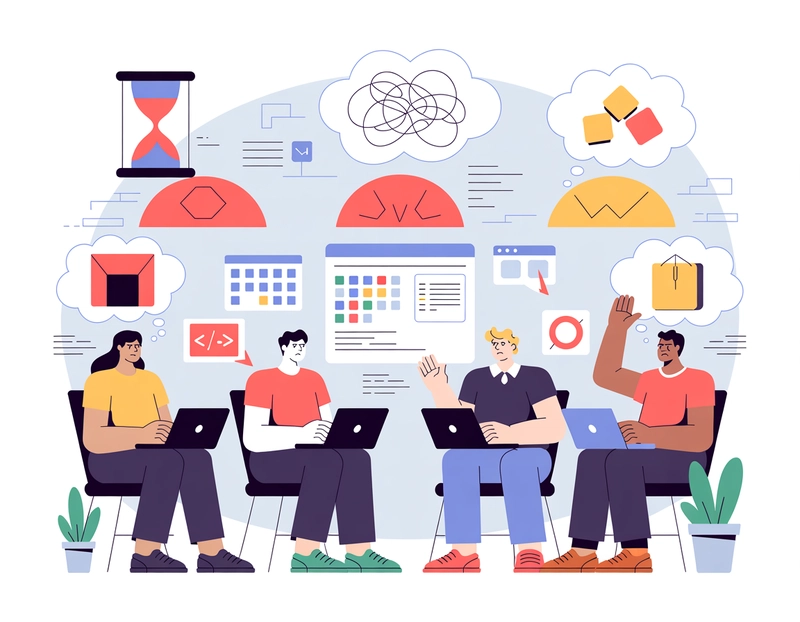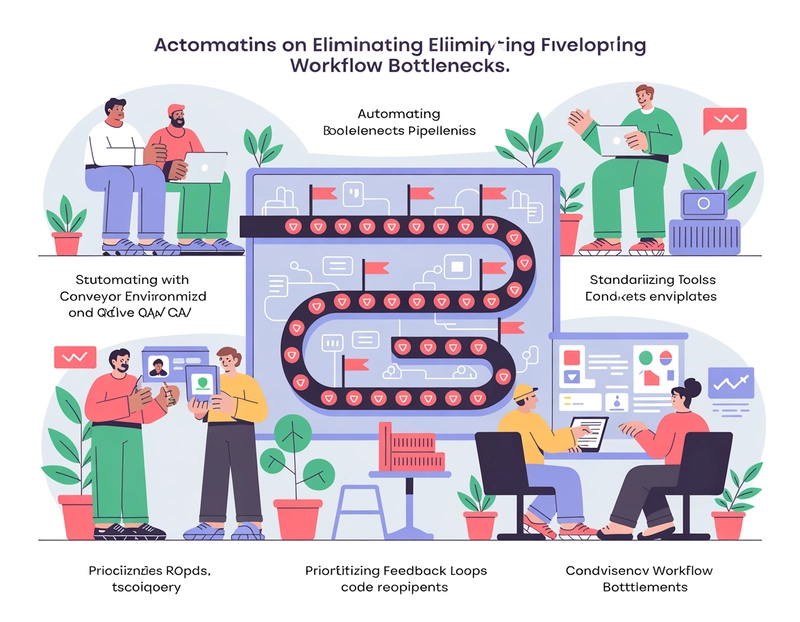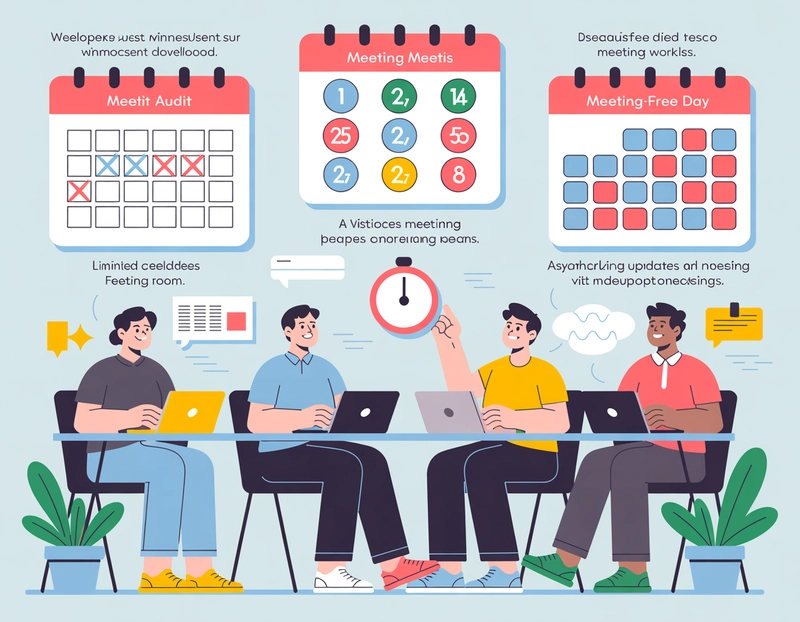Introduction
Developer productivity is not just about writing code fast. It’s about keeping teams in flow, minimizing friction, and letting engineers focus on what matters. Yet, most dev teams face blockers: workflow bottlenecks, meeting overload, and communication breakdowns. These issues slow delivery, frustrate engineers, and hurt product quality.
This guide lays out practical, real-world strategies to remove these blockers. We’ll cover how to eliminate workflow bottlenecks, reduce unnecessary meetings, and use asynchronous communication to keep your team focused and creative.
Why Productivity Blockers Happen in Dev Teams

Productivity blockers in software development stem from:
- Slow build and test cycles
- Unclear or inconsistent environments
- Excessive or poorly structured meetings
- Siloed or delayed feedback
- High cognitive load from complex codebases
Each of these issues disrupts a developer’s flow. The cost is actual: context-switching, frustration, and wasted hours. Removing these blockers is essential for any high-performing software team.
Eliminating Workflow Bottlenecks
Find and Fix Bottlenecks Early
Bottlenecks often hide in plain sight: long build times, manual QA, or waiting for code reviews. Start by mapping your workflow. Identify where tasks pile up or progress stalls. Use metrics like cycle time, build duration, and review turnaround to spot trouble spots.
Key Strategies:
- Streamline repetitive tasks: Automate builds, tests, and deployments. Use CI/CD pipelines so code moves smoothly from commit to production.
- Automate environment setup: Use containerized development environments (like Docker, Gitpod, or devcontainers) so every developer works in a consistent setup. This slashes “it works on my machine” issues and reduces onboarding time.
- Standardize tools and processes: Codify your workflow in scripts, templates, and documentation. This lowers cognitive load and helps new team members ramp up faster.
- Prioritize feedback loops: Schedule daily time for code reviews before starting new work. This keeps PRs moving and prevents bottlenecks in the review process.
- Regular workflow reviews: Hold retrospectives to review what’s slowing the team down. Adjust processes based on accurate data and feedback.
💡
Example:
A team at a fintech company cut build times from 10 minutes to 5 by using cloud-based CI runners and hot-reloading. This saved each engineer an hour daily, freeing time for more profound work.
Reducing Meeting Overload
Meetings Are Expensive- Use Them Sparingly
Developers need long stretches of focused time. Meetings, especially recurring or unfocused ones, disrupt the day and flow. Meeting overload leads to fatigue, stress, and lower output.
Practical Tips:
- Audit your meetings: List all recurring meetings. Cancel or combine those without clear value or agenda.
- Shorten meetings: Set default durations to 25 or 50 minutes. This keeps discussions tight and gives people breathing room between calls.
- Enforce meeting-free days: Block out at least one day a week for deep work. No meetings, no interruptions.
- Limit attendees: Invite only those who need to be there. Give others a summary or recording.
- Use a meeting timer: Stay on track and end on time.
- Leverage asynchronous updates: Replace status meetings with written updates in project management tools or chat threads.
💡
Example:
A SaaS team replaced their daily standup with async check-ins via Slack. Developers posted updates before noon; the team lead reviewed them in one go. This freed up 30 minutes daily per person and reduced context-switching.
Embracing Asynchronous Communication
Keep Developers in Flow with Async Tools
Synchronous communication (real-time chats, calls) is helpful for urgent issues, but constant pings and meetings break concentration. Asynchronous communication lets developers respond on their schedule, preserving deep work.
Best Practices:
- Set clear response expectations: Define what’s urgent (needs a quick reply) and what can wait (respond within 24 hours).
-
Use the right tools:
- Project management: Teamcamp, Jira, Asana, and Trello are responsible for tracking tasks and making updates.
- Messaging: Slack and Microsoft Teams are used for threaded discussions and announcements.
- Documentation: Confluence, Notion, and Google Docs for sharing knowledge and decisions.
- Video: Loom for screen recordings and walkthroughs- great for complex feedback or demos.
- Be concise and explicit: Write clear, actionable messages. State what you need, by when, and any relevant context.
- Encourage documentation: Capture decisions and processes in a shared knowledge base. This reduces repeated questions and onboarding friction.
- Regular async check-ins: Weekly written updates keep everyone aligned without a meeting.
💡
Example:
A remote-first team used Loom to record code review feedback. Reviewers sent short videos instead of scheduling calls. Developers watched and responded when ready, reducing meeting time and improving clarity.
Real-World Tools and Workflows
Automate and Standardize
- CI/CD Pipelines: Jenkins, GitHub Actions, GitLab CI for automated builds, tests, and deployments.
- Containerized Dev Environments: Docker, Gitpod, or VS Code devcontainers for consistent setups.
- Project Management: Jira, Asana, and Trello for tracking work and priorities.
- Async Communication: Slack, Microsoft Teams, Loom for updates and feedback.
- Documentation: Confluence, Notion, Google Docs for living documentation.
Methodologies That Help:
- Kanban: Visualize work, limit work in progress, and focus on flow.
- Agile Retrospectives: Regularly reflect and adapt processes to remove friction.
- Code Review Rotations: Assign daily code review slots to keep PRs moving and avoid review pileups.
Preventing Future Blockers
- Continuous feedback: Encourage team members to flag blockers early and suggest improvements.
- Regular training: Keep the team updated on new tools and best practices.
- Proactive environment management: Centralize updates and dependency management to avoid local setup drift.
- Celebrate improvements: Recognize when a process change saves time or reduces frustration.
Conclusion: Build a Productive, Flow-Driven Dev Team
Removing productivity blockers is not a one-off task. It’s an ongoing process of listening, measuring, and refining how your team works.
By eliminating workflow bottlenecks, reducing meeting overload, and embracing asynchronous communication, you create an environment where developers can focus, collaborate, and deliver their best work.
If you want to take your team’s productivity to the next level, explore tools like Teamcamp for project management.

Try Teamcamp for free
With the proper workflows and tools, your team can spend less time fighting friction and more time building great software.
Ready to remove blockers? Start small: audit your meetings, automate a workflow, or try an async update today. Your future self and your team will thank you.








Top comments (0)